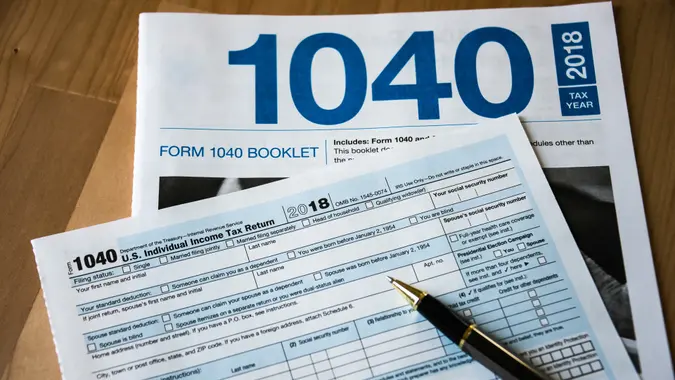9 Legal Tax Shelters To Protect Your Money

Commitment to Our Readers
GOBankingRates' editorial team is committed to bringing you unbiased reviews and information. We use data-driven methodologies to evaluate financial products and services - our reviews and ratings are not influenced by advertisers. You can read more about our editorial guidelines and our products and services review methodology.

20 Years
Helping You Live Richer

Reviewed
by Experts

Trusted by
Millions of Readers
When it’s time to settle with Uncle Sam at the end of the year, don’t overlook some IRS-approved tax shelters that might lower your tax bill. A good tax shelter is a legal way for a taxpayer to shelter, or protect, income against taxation, according to the Tax Policy Center. And you can protect your earnings from taxes without resorting to a Swiss account, overseas legal tax havens or tax-dodger schemes.
Review these nine legal tax shelters that can save you a bundle because everyone wants to reduce their taxable income and save money by taking every deduction they can.
Legal Tax Shelters
There are many ways to reduce your tax burden, but make sure you aren’t illegally evading taxes by using a legal tax shelter. Here are nine of the best tax shelters you can use to reduce your tax burden.
1. Set Up a Retirement Account
A 401(k) or other types of tax-deferred retirement account like an individual retirement account allows you to save money on taxes now by deferring to pay taxes in retirement when your income and tax bracket are likely lower. For the tax year, you were able to contribute up to $6,000 to a traditional IRA or $7,000 if you were 50 years of age or older. For 401(k) investment accounts, you could’ve contributed up to $20,500. Those age 50 or older could’ve contributed up to an additional $6,500 as a catch-up contribution.
The limits increase in 2023. The maximum IRA contribution this year is $6,500, or $7,500 if you’re age 50 or older. The limit for 401(k)s increases to $22,500, plus $7,500 in catch-up contributions.
Remember that your tax-deferred retirement funds will be taxed when you withdraw the money in retirement.
Keep in mind that because you could fall into a lower tax bracket when you retire, it might be a good idea to begin contributing to a tax-deferred retirement account now.
2. Buy a Home
Purchasing real estate is another way to set up a tax shelter because you can claim several deductions that renters cannot, although you’ll have to itemize deductions to take advantage of them. The IRS allows you to deduct qualified expenses related to owning a home, including real estate taxes, home mortgage interest and mortgage insurance premiums.
You can also deduct the sales tax you paid on your home, such as for a manufactured or modular home, or for building materials for new construction. However, that could have consequences later because it reduces your cost basis, which is used to calculate depreciation and capital gains. Consult with a tax professional before you take the deduction.
The combined total deduction for state and local income, sales and property taxes is $10,000 ($5,000 for married couples filing separately). Other limits may apply.
3. Protect Your Capital Gains
If you earn a significant profit from selling your home, you can protect it from being taxed if you meet certain requirements. You need to pass an IRS ownership and use test and report income reported to you on Form 1099-S, Proceeds From Real Estate Transactions.
Use Schedule D (Form 1040) to report the capital gain and Form 8949 to report the sale of your home. Single homeowners are allowed to exclude up to $250,000 of capital gains from their incomes, and married couples filing jointly can exclude $500,000.
4. Open a Health Savings Account
One easy way to reduce your tax liability is to open an HSA and set aside an estimated amount each year for your medical expenses. You must have a high-deductible health plan to open an HSA. With this HSA, you can use the nontaxable funds to cover out-of-pocket medical and health expenses for the year.
You can make contributions from your paycheck to fund the account or make your own deposits and then spend the money as you need it. For 2022, max contributions could’ve gone up to $3,650 if you covered only yourself or $7,300 if you had family coverage. Individuals age 55 or older could’ve made an additional catch-up contribution of $1,000.
The limits for 2023 increase to $3,850 if you cover only yourself and $7,750 for family coverage. The catch-up contribution remains at $1,000.
5. Become an Angel Investor
Angel investors invest in small businesses and startups. Going this route can potentially allow you to take a tax credit and give you a nice return on your investment if the business succeeds.
As an angel investor, you might qualify for a state tax credit that enables you to write off a portion of your investment right away. For example, angel investors in Colorado who invest at least $10,000 and meet other eligibility requirements receive a tax credit of up to 35% of their investment.
6. Use the Child Tax Credit
Don’t overlook the tax advantages of being a parent. Your children could help you protect some of your hard-earned dollars.
If the children are under age 17 at the end of the year and qualify as your dependents, you might qualify for the child tax credit. The child tax credit enables you to claim $2,000 per qualifying child. Up to $1,500 of that credit is refundable for each qualifying child.
You might also be able to claim the child and dependent care credit for qualified employment-related expenses, such as daycare for a child younger than 13. The maximum credit is $3,000.
7. Workplace Benefits
If you’re self-employed and using part of your paycheck to pay for health insurance, you might qualify for a deduction. In particular, you can deduct “premiums that you pay for medical, dental and qualifying long-term care insurance coverage for yourself, your spouse and your dependents,” according to TurboTax. The deduction is meant to lower your adjusted gross income, and thus, lower your overall tax liability. For those employed, you can itemize qualified medical expenses that exceed 7.5% of your AGI.
8. College Savings Plans
You can enroll in a college savings account, otherwise known as a 529 plan. A 529 plan is provided by a state or educational institution that allows for several tax benefits. For example, account earnings aren’t federally taxed when used for qualified educational expenses. Also, all qualified withdrawals aren’t subject to federal taxes.
In addition, many states offer partial tax deductions or tax credits based on their unique 529 plan. For example, Pennsylvania residents can deduct contributions up to $17,000 per beneficiary per year from their taxable income.
9. Owning a Business
As a business owner, you can deduct a variety of qualified expenses used to maintain the operation of your business. The IRS defines an allowable expense as being “both ordinary and necessary,” and not used to figure the cost of goods sold, capital expenses and personal expenses. Some of the business expenses you can deduct include: employees’ pay, retirement plans, interest and insurance. And for small-business owners, you can also deduct use of your car and your home if used for your business.
More From GOBankingRates
Sabah Karimi and Daria Uhlig contributed to the reporting for this article.
 Written by
Written by  Edited by
Edited by 

























